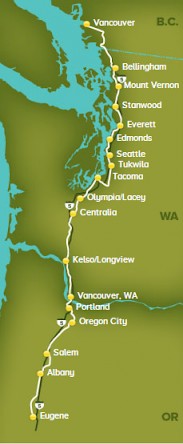Happening Now
NARP responds to another attack on trains by CNN's Anderson Cooper
March 28, 2013
Written By Sean Jeans Gail
 So is Anderson Cooper still a real journalist? He headlines a daily talk show, and was swimming with crocodiles on last Sunday’s 60 Minutes. Perhaps Cooper has completely transitioned into the role of “television personality.”
So is Anderson Cooper still a real journalist? He headlines a daily talk show, and was swimming with crocodiles on last Sunday’s 60 Minutes. Perhaps Cooper has completely transitioned into the role of “television personality.”
Honestly, that’s the most generous conclusion we can come up with. Because after the fact-light, context-free piece showcased on Anderson Cooper 360 last week, we have to say: if Cooper still considers himself a reporter, he is doing a very bad job of it.
On Cooper’s show, reporter Drew Griffin attacked the High Speed & Intercity Passenger Rail (HSIPR) Program as a boondoggle, contrasting the expectation of 220 mph trains that run in Europe and Asia with the projects funded in the United States by HSIPR.
Griffin points to the federally funded improvements to the Pacific Northwest’s Cascadesservice (Portland, Oregon – Seattle, Washington – Vancouver, British Columbia) as an example of everything that’s wrong with the HSIPR program. In his “analysis,” Griffin states that $800 million was spent to bring about a ten minute reduction in trip time.
But that’s not true.
Yes, there was a ten minute reduction in trip time. However, the $800 million also paid for infrastructure upgrades that push on time performance above 88 percent, and added two additional daily round trips between Portlandand Seattle. While Paula Hammond, former head of the Washington State Department of Transportation, briefly mentions more roundtrips on camera, it’s never even acknowledged by Griffin. That’s right: the money will go to purchasing a new trainset and new locomotives, increasing daily roundtrips from four to six, and Anderson Cooper didn’t even mention it! (Not incidentally, these trainsets are being built in the U.S. by American workers. This investment is leading to a revival in U.S. manufacturing of rail equipment.)
Griffin also repeatedly states that there’s nothing to show for the $12 billion spent on highspeed rail. In addition to being disrespectful to communities that have directly benefitted from the many improvements to conventional speed train service (such as:Illinois, Vermont, Michigan, the entire Northeast Corridor, and so on), it’s also flat out wrong, because only 15 percent of the $12 billion has been spent so far.
There are many reasons for this. As a result of the U.S. investing so little in passenger rail over the past 50 years, a lot of the HSIPR program had to be built from the ground up, a process that has taken time. The projects have also been the victim of political squabbling, with Republican governors killing rail expansion projects—conventional and high speed—in Wisconsin, Ohio, and Florida. (In a twist of fate, Wisconsin Governor Scott Walker reversed course and applied for a HSIPR rail grant in the next round of applications, and Florida Governor Rick Scott is supporting All Aboard Florida’s Miami-Orlando train, a service which would have benefited immensely from the Orlando-Tampa rail corridor Scott killed).
California’s San Francisco-Los Angeles high speed train—which will travel at speeds of more than 200 mph—is facing many of these political hurdles. But it is moving forward in spite of the political opposition, with construction scheduled to start this very summer. Construction will also ramp up on HSIPR projects in the Midwest and Northeast, creating good jobs for the U.S. construction workers, an industry which is still lagging behind in the recovery. New orders for train equipment will continue to benefit the U.S. manufacturing sector.
Griffin and Cooper’s main objection seems to be the gulf between what they imagined when President Obama talked about highspeed trains, and the reality of what $12 billion can buy. Their main failing, then, is understanding that infrastructure—whether it be rails or roads, bridges or sewers—is expensive. Unfortunately, with an estimated $3.6 trillion in investment needed in the U.S.between now and 2020, there are no $12 billion silver bullets.
This country is still pursuing the 200 mph train service President Obama spoke of—in the Northeast Corridor and in California. But unless we start investing on levels commensurate with what the Chinese have spent on their high speed rail network—$451 billion to $602 billion between 2011 and 2015 alone—the rest of the country will progress in increments of 10 minute reductions here, and an additional frequency there.
But if you ask a potential Cascades passenger, someone who drives on Interstate 5, where bumper-to-bumper traffic can often stretch 60 miles south of Seattle, past Tacoma to the state capital of Olympia, ten minutes and another frequency would be enough.
"The Rail Passenger Association's recognition of the essential work done by SMART-TD members aboard Amtrak during this difficult period is appreciated. The Golden Spike Award serves as a testament to the compassion and dedication our conductors, assistant conductors and other workers exhibit constantly through times both ordinary and extraordinary."
Jeremy Ferguson, SMART-TD President
December 21, 2021, on the Association awarding its 2021 Golden Spike Award to the Frontline Amtrak Employees.
Comments